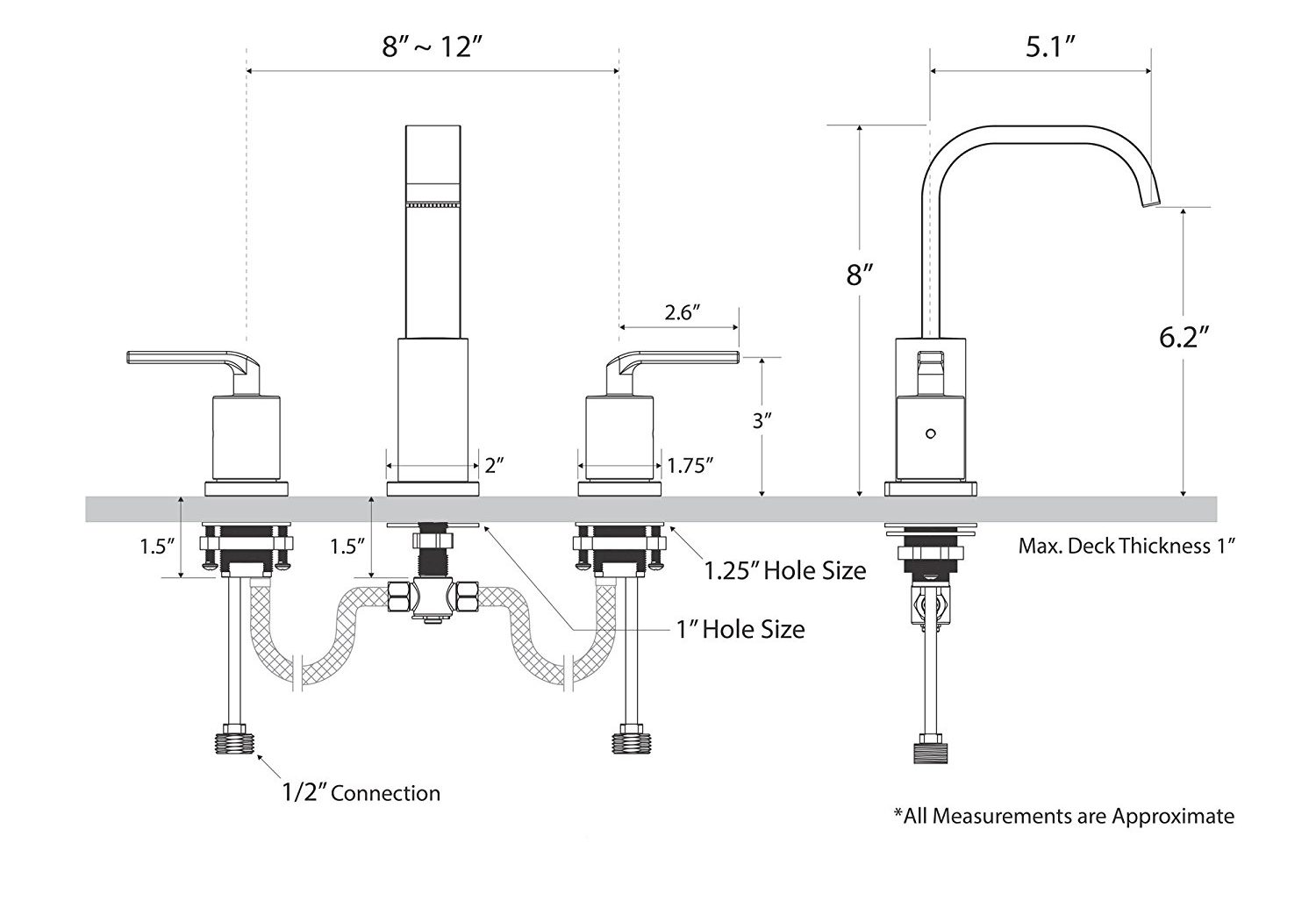My super basic faucet handles are exactly that…you twist it left-right to set temp and tilt it up-down for pressure from off to full. We just leave it rotated wherever we like it for temp and tilt up to turn on each time to the desired pressure. Our water pressure is always variable, so the amount tilted up varies, but the “rotational temp” almost never needs changing. There’s no fancy thermostatic valve in these like some shower have. There’s even those fancy kitchen sink faucets that remember everything and you just tap them with your hand and they automatically turn on/off to your settings of temp and pressure. I think they are called “touchless faucets”. Pretty sure even Ikea sells one.
I feel like sink handles like mine are super common, too. I’ve had similar ones in the states and in Europe…
Have you tried using your own memory?
Not needed because you shouldn’t be using warm water to wash your hands. Cold only.
Why?
What I read is that cold water cleans just as well as warm water but uses less energy, therefore better for the planet overall.
I agree it is more comfortable, but that was my reasoning.
While this is true, washing your body doesn’t need warm water I’d like to make two points:
-
It’s more comfortable to bathe/shower in warm water
-
Hot water is handy for washing dishes by breaking up hardened, sticky substances and not everyone has a dishwasher.
- Bathing/showering, yes, agreed.
- Hot water for dishes is different than what OP was talking about.
-
(found the brit)
Canadian.
…brit-canadian, french-canadian, or albertan?..
Something like this works. Just turn the water off with the spray nozzle, not the handle. https://share.google/1HpxlLwZ6RMXGdMoS
I used to have a kitchen sink faucet with the mixing handle on the side, that i installed after the 2 tap mixers.
So the 2 taps controlled hot and cold, which fed into the faucets cold line, and the hot line was capped off, making the handle only control flow, and temp was the 2 knobs. (I did this out of laziness because I didnt want to unsolder and resolder in new fittings)
There are! They’re called thermostatic faucets.
I have a feeling like you could do a completely mechanical one. Like a way to push it open and a part gets pushed out to stay put so when you open the faucet back up it bumps it and has a little resistance when it first turns so you don’t accidentally move it. Rotate the full way around to reset.
I’m amazed at the comments explaining incoming water temperature fluctuations and pressures…
No no, thermostatic tap/faucet mixes waters depending on the output temperature. Ignores all of the variables except the thermal mass (I guess reaction speed) of the thermostatic system.
I think they are normally like 10x the price of a standard mixer tap tho.
So, it’s a budget choiceYeah, and obviously if the ‘hot’ water isnt hot, there isn’t anything it can do.
When I bought the faucet for my bathtub, the regular one was 35€ while the thermostatic one was 60€. I wonder why they still make the regular ones
Yeh, bath/shower ones seem affordable.
But for a standalone sink, they seem to be significantly more.
single handles are all well and good, but I’d prefer a hot knob, a cold knob, and a flow knob. I’ve never been clear why this isn’t done, I suppose its probably cost. Maybe there is some wear and tare reason?
Seperate hot and cold knobs in showers are against code in a lot of places
Isn’t this thread about sinks?
Ah shit, you’re right. My brain just saw ‘faucet’
Why would you need separate hot and cold knobs if all that matters is the ratio between them?
Because sometimes you want full cold, sometimes you want full hot. Yes you could use a three way valve but you’d generally lose maximum water pressure.
I’m so confused. What do the cold and hot knows even do?
they set the relative flow/pressure of respectively hot and cold water. The tap sets the total flow from minimum to maximum available based on the pressure supplied from.thenother two, allowing the selected hot/cold ratio to be preserved between on/off cycle, while also allowing for just a small stream of water when you need it, or a full flow of water when you need to fill a vessel or blast a dish.
I don’t understand how what you’re suggesting could work any differently than a standard mixer tap, where if you want full cold you turn it the way to cold, and pull all the way to fully open. You say “you’d generally lose maximum water pressure” - how does the mechanism you’re thinking of actually set the ratio of hot to cold, and how does it not lose pressure?
zheres your standard two tap mixer faucet:

At both taps full open you have full flow/pressure from both the hot water and cold water supply only restricted by the valve full open orifice.
Now add an additional valve to the mixed outlet of the faucet with both hot and cold feeding into the line that runs into it. If the valve is sized to accommodate the full flow from both valves feeding into it, the full combined pressure/flow from both cold mains and hot supply is available.
Also, once you set the temperature you like by turning the temp taps, that temp will be available to you at any flow rate on demand. Nothing you do to the mixed valve will change the temperature of the flow. This is especially useful if your hot temperature is very hot, you can have nice warm water to wash your hands every time without worrying you might scald yourself.
Ok, but what’s wrong with a standard single lever mixer, or a two handle (temp and flow) mixer? Never had a problem with them.
I’m not familiar with a temp and flow two handle mixer for a sink faucet. That could work well if the temp valve is full bore.
Single handle faucets dont replicate temps, you have to guess approximate temp each time and they are almost always center biased.
But you can easily remember the approximate position of the lever, which is all you really need to get appropriately warm water for hand washing. The problem with normal hot and cold taps is really that it’s hard to replicate the settings, even approximately. (Also, while you can try to remember “half turn cold, two turns hot”, you then have to do arithmetic to get any different flow - ew)
Since the cold water supply will fluctuate in temperature from day to day, you won’t actually get exactly the same temp unless you use a thermostatic mixer (which exist for showers but I’m guessing are hard to find if they exist for sinks, because… why would you need one?) even with your solution - so I think the single lever version is always good enough.
I don’t understand what centre-bias means here.
The only correct kind of faucet is the kind with a thermostatic handle for temperature, and a separate handle for flow.
They are almost exclusively available for showers and that’s stupid. It’s the correct solution for the problem, with extremely few drawbacks.
The only improvement I could see is making the temperature handle short circuit to the drain until the water going through is hot enough. But I dont know if that’s really possible without electronics, and I really dont want my faucet handles to be plugged in or take AA batteries.
YES, I remember this Sweden when I went there and it’s amazing.
Indeed :). That’s what these are.

everytime
Not a word, my dude.
they will be ok in life
I bet it would not be hard to 3d print a little ring with a twisty arrow that you could use to “save” your last handle placement, kinda a neat idea.
deleted by creator
You mean a (single handle) mixer tap?
We have mixer taps in our bathroom sinks and showers. Just lift the handle up and the temp is the same as it was last time you used it.
would love indexing and numbers on my handle
or just go full Japan and incorporate a thermostat
That’s not even Japan, any European country has that as standard on showers
oof, you caught me red-handed, USian here 😭 <greatest country on earth she says between sobs>
It’s reasonably common for showers to have a mixing valve and a flow rate valve on separate handles. That accomplishes what you want. You just have to remember which is which and only use the flow rate valve to turn on and off.
More importantly, hot water circulation systems should be more common. It’s the waiting for the cold water in the line to flush out that really makes setting temperature a hassle.
and when the hot water heater is two floors down and the pipe from there runs up unheated parts of the building, it takes a very long time to get even a hint of warmth out of the hot water faucets.
i’ve lived 3 minutes away from hot water for nearly thirty years now. it sucks. if i ever get money enough to own a house, or choose where i live with little regard to cost, it will have instant hot water (tankless water heaters).
I thought a hot water circulator would be great, and it kind of is, but it comes with a drawback that I hadn’t considered. If you want cold water from the tap, to fill a glass of water at night for example, you have to wait for that just as long as you would have had to for the hot water before!
The solution to that is for a third return line to be run during a new build or remodel, but that’s definitely not a weekend project for most homes.
hot water circulation systems should be more common
That just sounds like a waste of energy. Why not have the water heater right next to your shower, so that there’s no wait? It’s how it was set up in my parents home. Really enjoyed that setup, never had to wait for hot water.
Because the kitchen isn’t always wall to wall with the bathroom?
That’s still confusing to me. My parents had the water heater tank in the bathroom, between the shower/bath and the sink. The kitchen sink had a separate small water heater.
It’s really a question of whether you have electric heating or a furnace or district heating.
It’s not common to have more than one heat exchanger for hot water if you have a furnace or district heating.
Electrical is much easier. You can just place them anywhere and they don’t cost as much to install. However, electricity is usually more expensive than district heating.
Most houses in the US have a single water heater, usually in the basement or utility room, with pipes running all through the house.
I once had a place with the separate small water heater for kitchen. Could barely get the dishes done. I prefer having to wait a minute for the bathroom gigantic tank water to make it to the kitchen. Actually my system is way more complex, but that’s irrelevant for this discussion. I have 3 big tanks, two of which are powered by wood (so usually cold unless it’s cold outside and I make fires). By turning some valves on or off I can get water from different tanks to different faucets, though not all combinations are possible. Perks of a 40 year old house that grandpa later made more improvements on, lol
Depending on your location the wasted water from letting the faucet run can be much more valuable than the energy needed to maintain a circ system, however install cost is high and the lines need to be entirely insulated so really, new construction works best. I wanted it on my house but I think it’d just drive costs way up, especially with a tankless as it’d be firing all the damn time.
I assume electric showers are pretty rare over there? We’d have like a 16mm2 cable ran to the bathroom for a 10.5kW shower. And with one of those it’s practically instant heat, and enough to heat high flow.
I’ve never seen one. We’ve got on-demand water heaters that feed entire homes, but the electric versions are notorious for breaking a lot. The trend is toward heat pump hot water storage tanks that cool the air around them and put that heat into the water tank.
Thanks for info, good to learn.
I’ve seen some videos about those, my understanding is that they’re used in warmer climates where the cold water line is already relatively warm year round.
I prefer a water shower, thanks
I’m irritated by these half-measures. Just bathe in the hot water heater!
Actually, fuck yeah. My parents also have one of those bad boys:

It’s really nice to bathe in!
As a kid, I saw an old movie with one of these in action. A dude and a lady were victims about to be eaten with the soup, and had to move around in it swishing the liquid and tipping the pot. Good stuff…
On demand recirculating works reasonably well but only for people who tolerate it. Push button, wait 3 min, water hot. It works for me but I know it’s way too much trouble for other people. It saves water and energy.
If you have a consistent schedule, you can also use timers for those so you don’t always need to remember to run it.
Oh, yeah, that makes much more sense actually. Now I kinda want that setup, but I bet it’s expensive.
The basic recirculation system is less than $300. Controlling the pump is the only thing you would have to add.
The pump comes with a built-in timer so you could turn the pump off while you sleep but that is not very granular.
A $15 relay plug will handle it no problem. How you control that relay plug is a rabbit hole- you can use the normie apps and their cloud servers crawling your local network but you get voice commands and remote control with very little effort. Or you can set up home assistant and have the pump run every time you turn on the bathroom lights, and when you unplug your phone from overnight charging, and when your phone connects to the house Wi-Fi upon arrival home from work.









